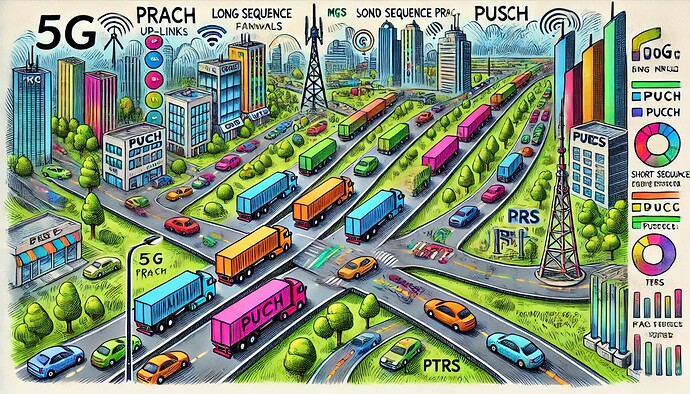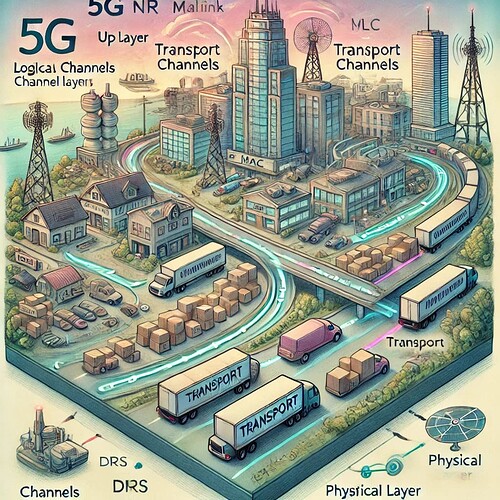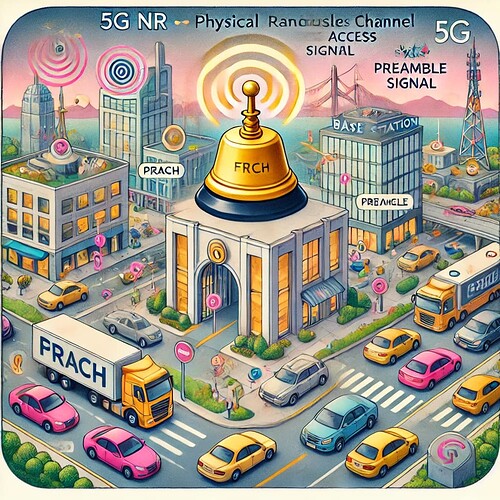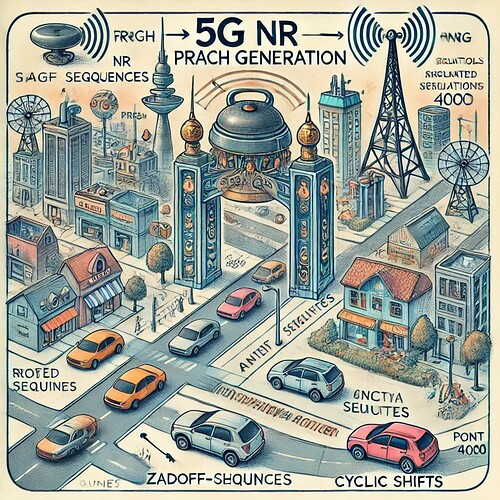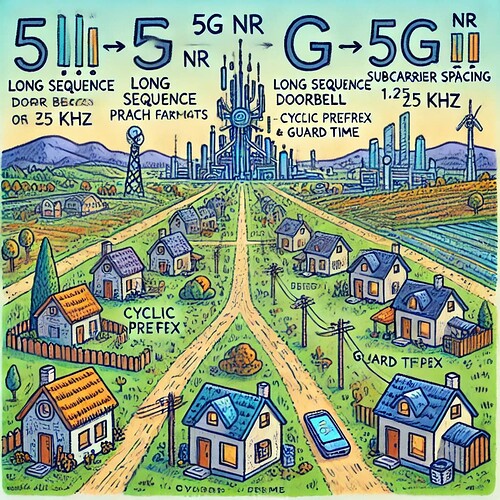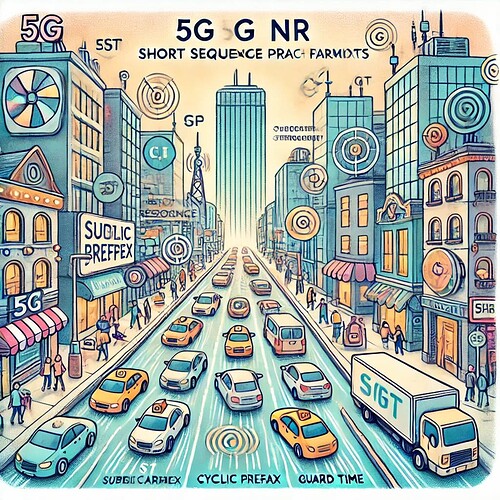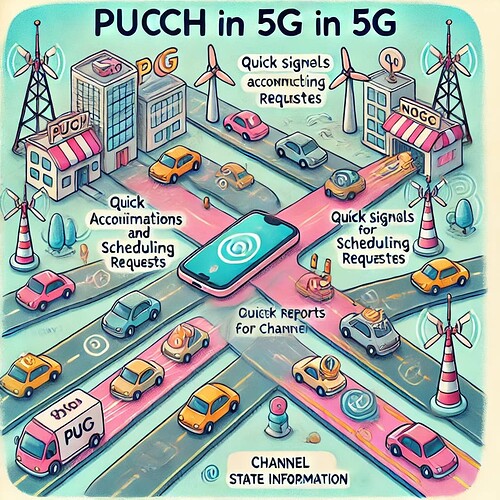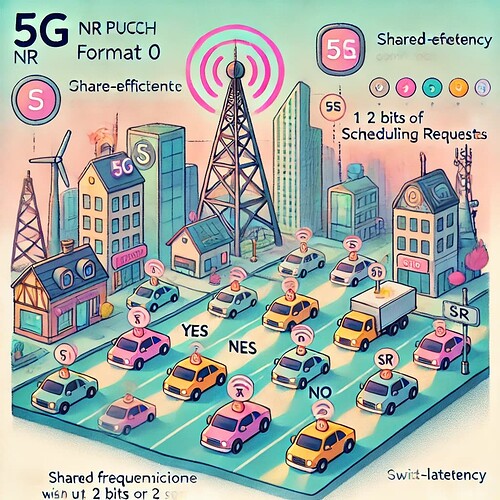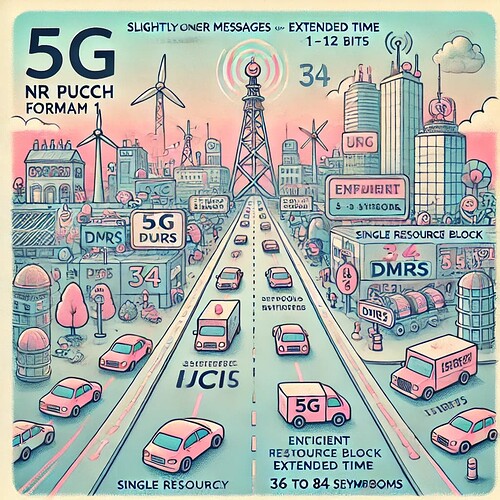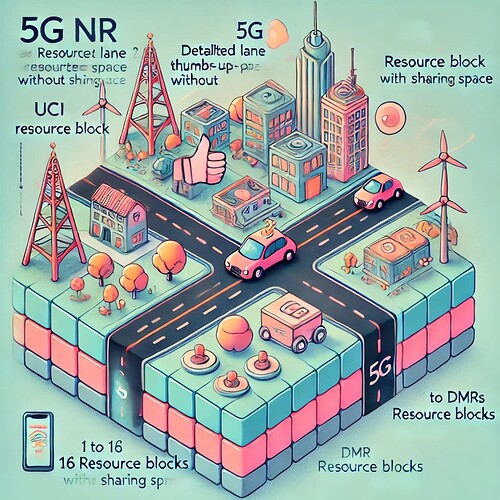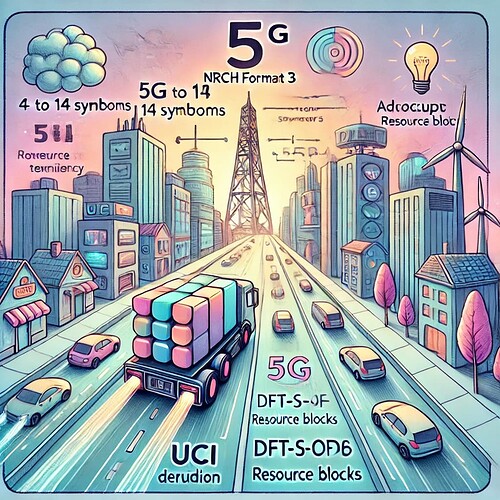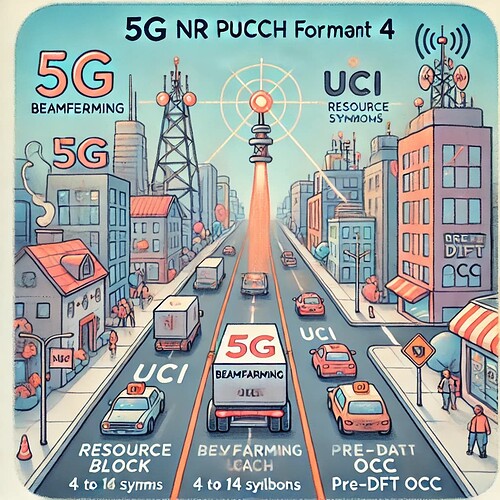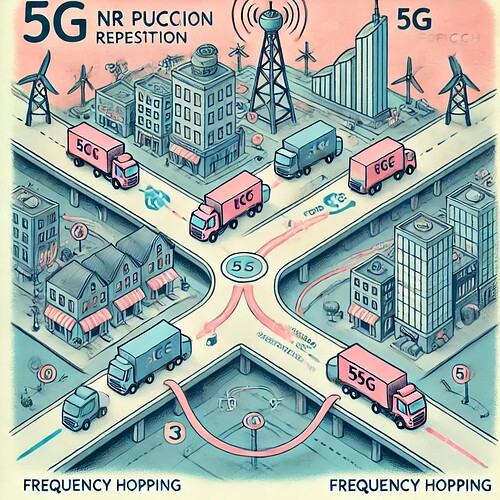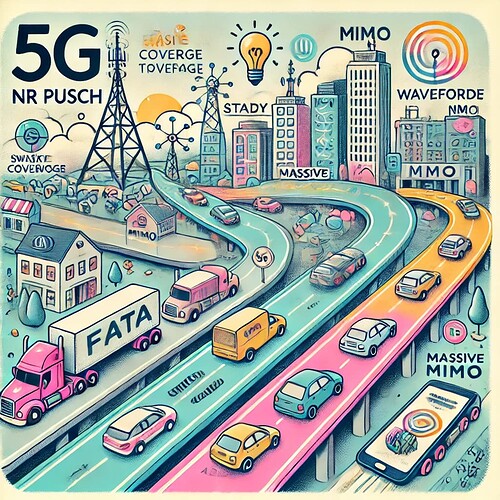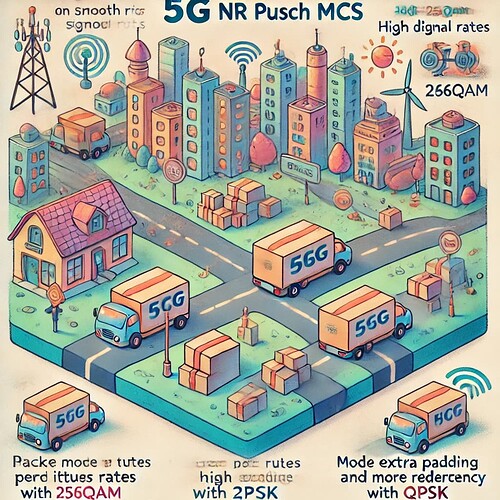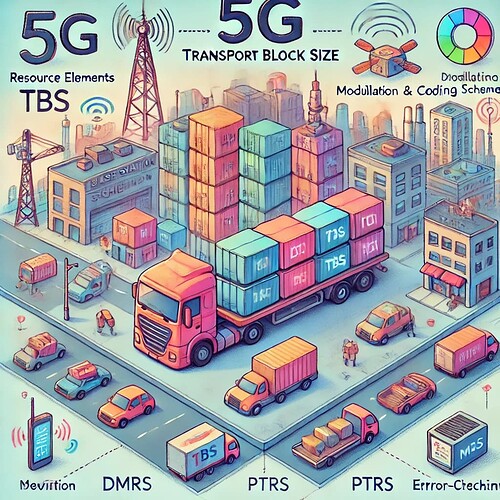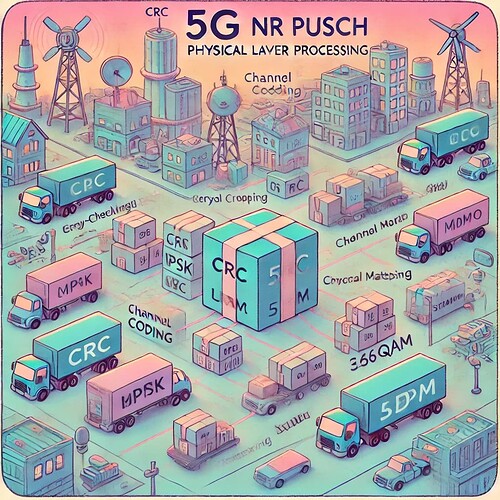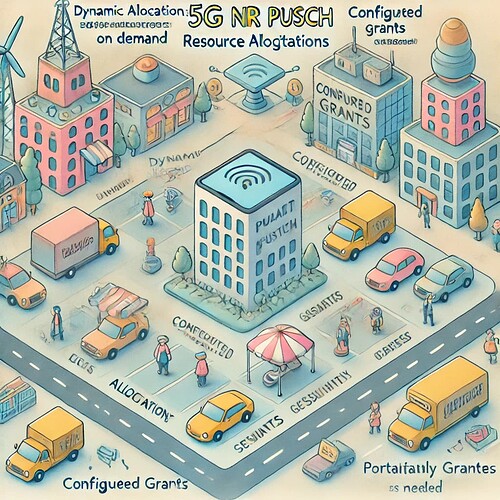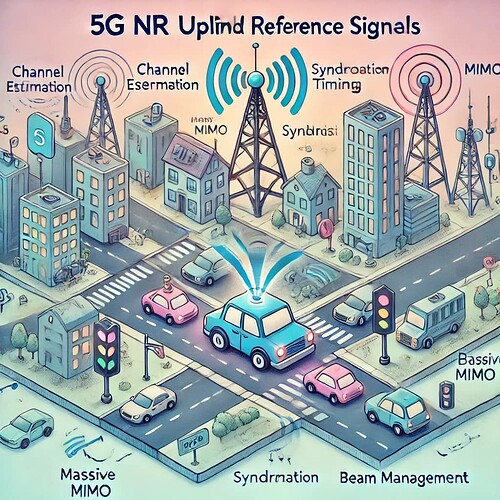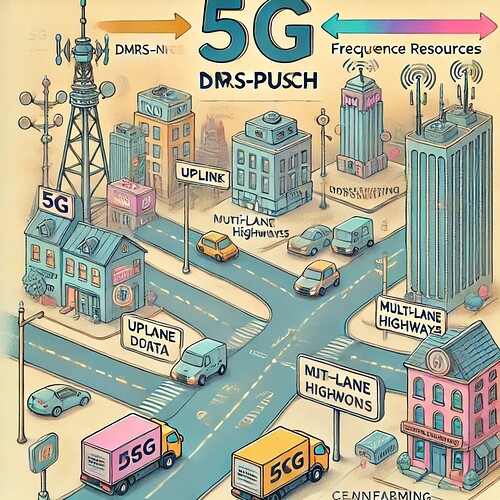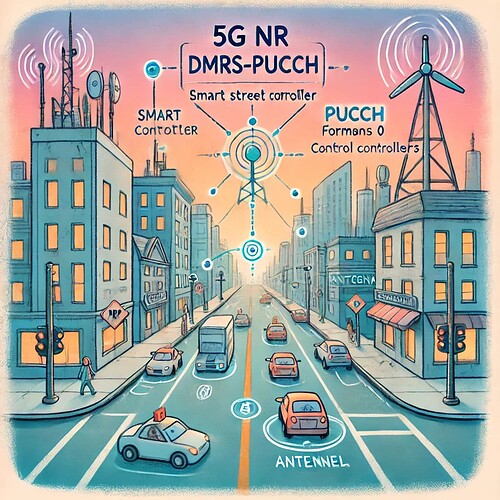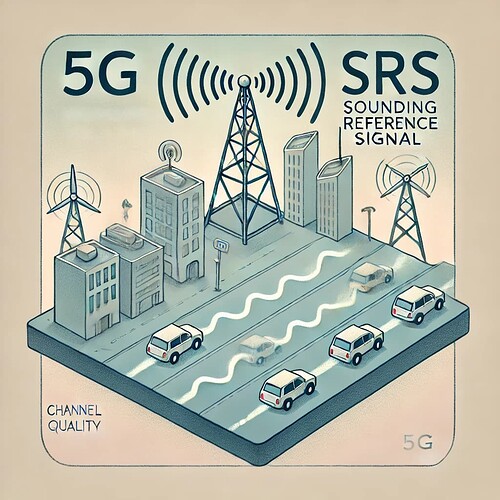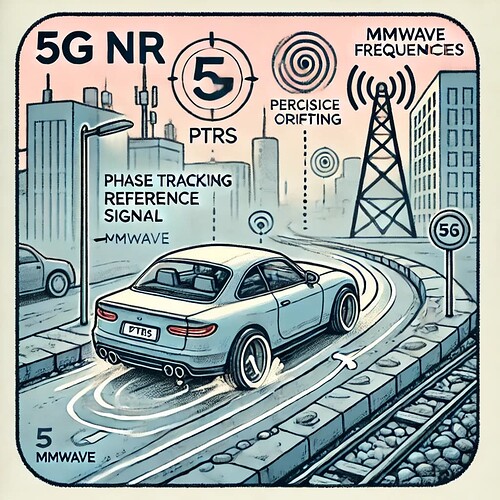This topic presents in a very simplified way all the main concepts that should be understood by those who know 5G NR.
5G NR Uplink Signals And Channels
5G NR uplink signals and channels enable efficient and reliable communication from devices to the network by utilizing a variety of specialized features. Uplink Channel Mappings categorize data flows into logical, transport, and physical channels for seamless processing. The PRACH (Physical Random Access Channel) facilitates initial connections, with Long Sequence PRACH Formats optimized for rural coverage and Short Sequence PRACH Formats tailored for high-frequency, urban deployments. PUCCH (Physical Uplink Control Channel) handles control information like acknowledgments and scheduling requests, offering five formats (Format 0–4) for different payload sizes and durations, with PUCCH Repetition enhancing reliability under poor conditions. PUSCH (Physical Uplink Shared Channel) is the main channel for sending user data, with its efficiency boosted by features like Modulation and Coding Scheme (MCS) for adaptive signal quality, Transport Block Size (TBS) for optimized data packet sizes, and advanced Physical Layer Processing for error correction and resource utilization. Resource Allocations ensure fair and efficient use of frequency and time resources through dynamic or preconfigured grants. Supporting signals include Uplink Reference Signals like DMRS-PUSCH and DMRS-PUCCH for decoding data accurately, SRS (Sounding Reference Signal) for assessing channel conditions, and PTRS (Phase Tracking Reference Signal) for correcting phase noise at high frequencies. Together, these elements ensure fast, adaptive, and reliable communication across a variety of scenarios, from dense urban environments to high-speed rural connections. Compared to LTE, 5G NR significantly enhances these features, introducing innovations like Short Sequence PRACH Formats and PTRS, enabling higher efficiency, better scalability, and reliable performance in complex and high-frequency scenarios. [In a Nutshell: 5G NR uplink channels and signals work together to provide efficient and reliable device-to-network communication, tailored for various environments and use cases.]
![]() In the world of 5G and LTE cities, uplink signals and channels are the lifelines connecting devices (cars) to the city’s hub (the network). LTE City had efficient roads, but 5G City upgrades to smarter highways, advanced traffic systems, and faster deliveries. Entry begins with the PRACH doorbell (Physical Random Access Channel), with Long Sequence PRACH Formats for rural neighborhoods and Short Sequence PRACH Formats for busy urban areas. Cars delivering updates use PUCCH highways (Physical Uplink Control Channel), choosing one of five lanes (Formats 0–4) depending on message size and urgency, sometimes repeating messages (PUCCH Repetition) in tough conditions. Larger deliveries take the PUSCH superhighway (Physical Uplink Shared Channel), where MCS rules set cargo limits, TBS ensures efficient packing, and Physical Layer Processing protects cargo en route. Smart traffic lights (Resource Allocations) guide cars, while DMRS street markers (Demodulation Reference Signals) keep them on track. SRS echoes (Sounding Reference Signals) assess road conditions for future traffic, and PTRS steering systems (Phase Tracking Reference Signals) ensure smooth navigation on high-speed, mmWave roads. These systems work together in 5G City, enabling fast, safe, and efficient deliveries, even in the busiest or most remote areas. [In a Nutshell: 5G City’s advanced uplink system ensures smart, efficient, and reliable data delivery across a modern communication landscape.]
In the world of 5G and LTE cities, uplink signals and channels are the lifelines connecting devices (cars) to the city’s hub (the network). LTE City had efficient roads, but 5G City upgrades to smarter highways, advanced traffic systems, and faster deliveries. Entry begins with the PRACH doorbell (Physical Random Access Channel), with Long Sequence PRACH Formats for rural neighborhoods and Short Sequence PRACH Formats for busy urban areas. Cars delivering updates use PUCCH highways (Physical Uplink Control Channel), choosing one of five lanes (Formats 0–4) depending on message size and urgency, sometimes repeating messages (PUCCH Repetition) in tough conditions. Larger deliveries take the PUSCH superhighway (Physical Uplink Shared Channel), where MCS rules set cargo limits, TBS ensures efficient packing, and Physical Layer Processing protects cargo en route. Smart traffic lights (Resource Allocations) guide cars, while DMRS street markers (Demodulation Reference Signals) keep them on track. SRS echoes (Sounding Reference Signals) assess road conditions for future traffic, and PTRS steering systems (Phase Tracking Reference Signals) ensure smooth navigation on high-speed, mmWave roads. These systems work together in 5G City, enabling fast, safe, and efficient deliveries, even in the busiest or most remote areas. [In a Nutshell: 5G City’s advanced uplink system ensures smart, efficient, and reliable data delivery across a modern communication landscape.]
Skip to: Roadmap to 5G NR
- Uplink Channel Mappings
- PRACH (Physical Random Access Channel)
- PRACH Generation
- Long Sequence PRACH Formats
- Short Sequence PRACH Formats
- PUCCH (Physical Uplink Control Channel)
- PUCCH Format 0
- PUCCH Format 1
- PUCCH Format 2
- PUCCH Format 3
- PUCCH Format 4
- PUCCH Repetition
- PUSCH (Physical Uplink Shared Channel)
- PUSCH MCS (Modulation and Coding Scheme)
- PUSCH TBS (Transport Block Size)
- PUSCH Physical Layer Processing
- PUSCH Resource Allocations
- Uplink Reference Signals
- DMRS-PUSCH (Demodulation Reference Signal for PUSCH)
- DMRS-PUCCH (Demodulation Reference Signal for PUCCH)
- SRS (Sounding Reference Signal)
- PTRS (Phase Tracking Reference Signal)
Uplink Channel Mappings
In 5G, uplink channels are used for sending information from a device to the network. These channels are divided into three types: logical channels, which carry data between higher network layers; transport channels, which handle data between intermediate layers; and physical channels, which transmit data over the air. The uplink also uses signals like Demodulation Reference Signals (DMRS) and Sounding Reference Signals (SRS) to help the network measure and adjust for signal quality and channel conditions. Another signal, the Phase Tracking Reference Signal (PTRS), helps correct errors caused by phase noise, especially at higher frequencies. Together, these channels and signals ensure accurate and efficient communication from the device to the network. [In a Nutshell: Uplink channels and signals work together to ensure data from the device reaches the network efficiently and accurately.]
![]() Imagine LTE and 5G as big cities, where sending information from your phone to the network is like delivering packages to a central office. The journey starts with logical channels, which are like conveyor belts moving documents (data) from the sorting facility (RLC layer) to the distribution center (MAC layer). At the MAC layer, the documents are packed into boxes (transport blocks) and sent onto transport channels, which act like trucks carrying these boxes to the shipping dock (physical layer). From there, physical channels (vehicles) take the boxes across the city to the network. To keep deliveries on track, there are physical signals like traffic lights, road signs, and GPS. These signals help vehicles avoid getting lost, calculate the best routes, and ensure smooth deliveries. Special signals like DMRS act as road markers for estimating conditions, SRS checks for traffic patterns to help schedule routes, and PTRS corrects any issues like wrong turns caused by tricky weather. Together, these layers and signals make sure every package (data) reaches its destination safely and on time. [In a Nutshell: In the 5G city, layers and signals work like a well-organized delivery system to ensure your data reaches the network safely and efficiently.]
Imagine LTE and 5G as big cities, where sending information from your phone to the network is like delivering packages to a central office. The journey starts with logical channels, which are like conveyor belts moving documents (data) from the sorting facility (RLC layer) to the distribution center (MAC layer). At the MAC layer, the documents are packed into boxes (transport blocks) and sent onto transport channels, which act like trucks carrying these boxes to the shipping dock (physical layer). From there, physical channels (vehicles) take the boxes across the city to the network. To keep deliveries on track, there are physical signals like traffic lights, road signs, and GPS. These signals help vehicles avoid getting lost, calculate the best routes, and ensure smooth deliveries. Special signals like DMRS act as road markers for estimating conditions, SRS checks for traffic patterns to help schedule routes, and PTRS corrects any issues like wrong turns caused by tricky weather. Together, these layers and signals make sure every package (data) reaches its destination safely and on time. [In a Nutshell: In the 5G city, layers and signals work like a well-organized delivery system to ensure your data reaches the network safely and efficiently.]
- Search Forum
 5G NR Uplink Channel Mappings
5G NR Uplink Channel Mappings 
PRACH (Physical Random Access Channel)
The Physical Random Access Channel (PRACH) is used by devices to request a connection to the network, enabling initial setup and resource allocation. It exists in both LTE and 5G NR, but in 5G NR, PRACH has enhanced configurations to support a wider range of deployment scenarios, such as massive IoT and high-speed mobility. PRACH transmits preamble signals based on unique sequences, ensuring the base station can detect and differentiate signals from multiple devices. These signals can be repeated to improve detection, especially for devices located far from the base station. The base station uses PRACH signals to calculate timing adjustments and synchronize communication with the device. This ensures devices can establish connections efficiently and reliably, even in complex or challenging network conditions. [In a Nutshell: PRACH acts as a device’s request channel, helping the network detect, sync, and connect devices reliably, even in busy or distant scenarios.]
![]() The Physical Random Access Channel (PRACH) is like the “doorbell” that a car (your phone) rings when it wants to enter the 5G city (the network). When a car arrives at the city gates, it rings the doorbell to let the city control center (the base station) know it’s there and needs help getting in. This doorbell uses a special sound (preamble signals) that is unique to each car, so the city can identify who’s ringing, even if many cars arrive at the same time. In 5G’s advanced city (compared to LTE City), the doorbell has been upgraded. It’s louder and smarter, making it work even for cars far away from the city gates or on busy roads filled with vehicles trying to enter. If a car is far away, it might ring the bell multiple times to make sure it’s heard. The city control center uses this signal to figure out how far the car is and adjusts the gates so it can enter smoothly. This ensures every car gets into the city quickly and efficiently, no matter how large or busy the city becomes. [In a Nutshell: PRACH in 5G works like a smarter, stronger doorbell that ensures every car (device) can connect to the city (network), even in crowded or distant conditions.]
The Physical Random Access Channel (PRACH) is like the “doorbell” that a car (your phone) rings when it wants to enter the 5G city (the network). When a car arrives at the city gates, it rings the doorbell to let the city control center (the base station) know it’s there and needs help getting in. This doorbell uses a special sound (preamble signals) that is unique to each car, so the city can identify who’s ringing, even if many cars arrive at the same time. In 5G’s advanced city (compared to LTE City), the doorbell has been upgraded. It’s louder and smarter, making it work even for cars far away from the city gates or on busy roads filled with vehicles trying to enter. If a car is far away, it might ring the bell multiple times to make sure it’s heard. The city control center uses this signal to figure out how far the car is and adjusts the gates so it can enter smoothly. This ensures every car gets into the city quickly and efficiently, no matter how large or busy the city becomes. [In a Nutshell: PRACH in 5G works like a smarter, stronger doorbell that ensures every car (device) can connect to the city (network), even in crowded or distant conditions.]
- Search Forum
 5G NR PRACH (Physical Random Access Channel)
5G NR PRACH (Physical Random Access Channel) 
PRACH Generation
PRACH in 5G NR uses Zadoff-Chu (ZC) sequences for preamble generation - signals used for initial communication between a device and the network - ensuring robust synchronization. While LTE also utilized ZC sequences, 5G NR introduces more flexible formats and configurations to support diverse deployment needs, such as larger bandwidths and varying cell sizes. The PRACH generation process involves creating the Random Access preamble for this initial communication. A root sequence is selected based on the network’s configuration, such as rural or urban environments. Additional sequences are generated by applying cyclic shifts to the root sequence, maintaining critical properties like constant amplitude and low cross-correlation. These sequences are mapped to specific subcarriers in the frequency domain, tailored to the deployment scenario. The frequency-domain signal is then transformed into a time-domain signal using an Inverse Fast Fourier Transform (IFFT). To ensure reliability, a cyclic prefix and guard period are added to mitigate multipath delays and timing differences. The final signal is transmitted via antenna port 4000, enabling the base station to detect, synchronize, and establish communication with the device. [In a Nutshell: PRACH in 5G uses advanced signal generation techniques to synchronize devices and networks, ensuring efficient and reliable initial communication.]
![]() PRACH in 5G is like a “doorbell” that a car (your phone) rings to request entry into the advanced 5G city (the network). This doorbell uses a special tone (Zadoff-Chu sequences) that the city gates (the base station) can easily recognize. While LTE city also had a doorbell, the 5G version has been upgraded to handle larger gates, wider roads (bandwidths), and more diverse neighborhoods (cell sizes). The tone is created by selecting a melody (root sequence) based on the neighborhood - whether rural or urban - and adjusting it slightly for each car to ensure a unique ring pattern. These tones are sent through a specific antenna at the city gates, designed to travel clearly over long distances or noisy areas. When the city hears the doorbell, it identifies the car, calculates its distance, and adjusts the gates to let it in at the right time, ensuring smooth and efficient access even during busy times. [In a Nutshell: PRACH in 5G is a smarter, stronger doorbell that ensures every device gets synchronized access to the network efficiently, no matter the conditions.]
PRACH in 5G is like a “doorbell” that a car (your phone) rings to request entry into the advanced 5G city (the network). This doorbell uses a special tone (Zadoff-Chu sequences) that the city gates (the base station) can easily recognize. While LTE city also had a doorbell, the 5G version has been upgraded to handle larger gates, wider roads (bandwidths), and more diverse neighborhoods (cell sizes). The tone is created by selecting a melody (root sequence) based on the neighborhood - whether rural or urban - and adjusting it slightly for each car to ensure a unique ring pattern. These tones are sent through a specific antenna at the city gates, designed to travel clearly over long distances or noisy areas. When the city hears the doorbell, it identifies the car, calculates its distance, and adjusts the gates to let it in at the right time, ensuring smooth and efficient access even during busy times. [In a Nutshell: PRACH in 5G is a smarter, stronger doorbell that ensures every device gets synchronized access to the network efficiently, no matter the conditions.]
- Search Forum
 5G NR PRACH Generation
5G NR PRACH Generation 
Long Sequence PRACH Formats
Long sequence PRACH formats in 5G NR are designed for scenarios requiring extensive coverage, such as rural deployments, where devices are far from the network tower. These formats existed in LTE but have been adapted in 5G to support enhanced configurations for better timing precision and higher resilience. They use a long sequence length of 839, which enables greater coverage, better timing precision, and improved decoding at the base station. Long sequence formats include a longer cyclic prefix (CP) and guard time (GT) to handle extended propagation delays. They typically operate with small subcarrier spacings (1.25 kHz or 5 kHz), making them suitable for FR1 frequency bands. However, their longer duration makes them less ideal for delay-sensitive services or high-density environments. There are four long sequence formats, each tailored for specific deployment needs, with variations in sequence duration and CP length. [In a Nutshell: Long sequence PRACH formats are tailored for long-distance communication in rural areas, ensuring reliable synchronization over greater distances.]
![]() Long Sequence PRACH Formats in 5G NR are like loud, extended doorbells designed for houses located far from the city center (the network). These doorbells take longer to ring and are specifically made to reach homes in rural or remote areas, where the distance to the city gates (the base station) is much greater. While LTE also used similar long doorbells, 5G has refined them to provide better timing precision and more reliable communication, even over vast distances. These long doorbells include extra waiting time (cyclic prefix and guard time) to account for the delays caused by the long journey. They operate on narrow lanes (small subcarrier spacings of 1.25 kHz or 5 kHz), making them ideal for long-range communication but less suitable for busy, fast-paced areas. With four variations available, these doorbells are optimized for different scenarios, ensuring reliable entry even in the most distant neighborhoods. [In a Nutshell: Long sequence PRACH formats are like extended doorbells for remote houses, ensuring distant devices can connect reliably to the network.]
Long Sequence PRACH Formats in 5G NR are like loud, extended doorbells designed for houses located far from the city center (the network). These doorbells take longer to ring and are specifically made to reach homes in rural or remote areas, where the distance to the city gates (the base station) is much greater. While LTE also used similar long doorbells, 5G has refined them to provide better timing precision and more reliable communication, even over vast distances. These long doorbells include extra waiting time (cyclic prefix and guard time) to account for the delays caused by the long journey. They operate on narrow lanes (small subcarrier spacings of 1.25 kHz or 5 kHz), making them ideal for long-range communication but less suitable for busy, fast-paced areas. With four variations available, these doorbells are optimized for different scenarios, ensuring reliable entry even in the most distant neighborhoods. [In a Nutshell: Long sequence PRACH formats are like extended doorbells for remote houses, ensuring distant devices can connect reliably to the network.]
- Search Forum
 5G NR Long Sequence PRACH Formats
5G NR Long Sequence PRACH Formats 
Short Sequence PRACH Formats
Short sequence PRACH formats are new to 5G NR and are designed for small-cell deployments and high-frequency bands, such as urban environments or millimeter-wave frequencies. They are optimized for shorter transmission times and higher mobility scenarios, addressing use cases that LTE PRACH formats could not handle efficiently. These formats use a shorter sequence length of 139, enabling faster communication and reduced transmission time, making them ideal for delay-sensitive services. Short preambles utilize larger subcarrier spacings (multiples of 15 kHz), which suit smaller coverage areas and higher frequencies in both FR1 and FR2 bands. With nine short sequence formats, they offer flexibility in cyclic prefix (CP) and guard time (GT) lengths, ensuring efficient performance in dense networks. Their shorter duration makes them well-suited for time-sensitive applications, though they require more bandwidth resources than long sequences. [In a Nutshell: Short sequence PRACH formats enable fast and efficient connections in urban and high-frequency deployments, addressing scenarios LTE couldn’t handle effectively.]
![]() Short Sequence PRACH Formats in 5G are like quick doorbells designed for busy downtown areas with lots of activity and fast-moving vehicles. Unlike the longer, slower doorbells used for faraway suburbs (LTE), these short doorbells are faster and more responsive, perfect for small neighborhoods with high traffic, like urban centers or high-speed zones. They use smaller, quicker signals that take less time to ring, allowing faster communication between the car (phone) and the city gates (network). These doorbells are highly adaptable, with nine variations available to handle different levels of traffic and timing needs, ensuring smooth and efficient entry for cars in crowded areas. However, because they work quickly and across smaller spaces, they use more energy and resources compared to the longer doorbells used for rural zones. [In a Nutshell: Short sequence PRACH formats are like fast doorbells for busy city centers, ensuring quick and efficient connections in dense and high-speed environments.]
Short Sequence PRACH Formats in 5G are like quick doorbells designed for busy downtown areas with lots of activity and fast-moving vehicles. Unlike the longer, slower doorbells used for faraway suburbs (LTE), these short doorbells are faster and more responsive, perfect for small neighborhoods with high traffic, like urban centers or high-speed zones. They use smaller, quicker signals that take less time to ring, allowing faster communication between the car (phone) and the city gates (network). These doorbells are highly adaptable, with nine variations available to handle different levels of traffic and timing needs, ensuring smooth and efficient entry for cars in crowded areas. However, because they work quickly and across smaller spaces, they use more energy and resources compared to the longer doorbells used for rural zones. [In a Nutshell: Short sequence PRACH formats are like fast doorbells for busy city centers, ensuring quick and efficient connections in dense and high-speed environments.]
- Search Forum
 5G NR Short Sequence PRACH Formats
5G NR Short Sequence PRACH Formats 
PUCCH (Physical Uplink Control Channel)
The Physical Uplink Control Channel (PUCCH) carries uplink control information such as acknowledgments, scheduling requests, and channel state information. While it existed in LTE, 5G NR introduces additional formats and configurations to enhance flexibility and support advanced features like beamforming. PUCCH enables devices to send Uplink Control Information (UCI) to the network, including HARQ acknowledgments, Scheduling Requests (SR), and Channel State Information (CSI) reports. It consists of five formats defined in 3GPP TS 38.211, each tailored to different payload sizes and durations. Formats 0 and 1 are designed for small payloads, handling HARQ acknowledgments and SRs but not CSI reports, whereas Formats 2, 3, and 4 support larger payloads and include CSI reports. Formats 0 and 2 prioritize short durations for low-latency applications, while Formats 1, 3, and 4 use longer durations to improve coverage and capacity. Formats 0, 1, and 4 operate on a single Resource Block, with Format 4 offering moderate capacity, while Formats 2 and 3 span up to 16 Resource Blocks, with Format 3 providing the highest capacity. Each format is optimized to balance payload size, latency, and coverage, ensuring efficient communication for various scenarios. 5G NR PUCCH is highly flexible in both the time domain and frequency domain. [In a Nutshell: PUCCH in 5G NR enables devices to send control information efficiently, with five formats optimized for different payload sizes, latency, and coverage needs, ensuring flexible and reliable communication.]
![]() The Physical Uplink Control Channel (PUCCH) carries uplink control information such as acknowledgments, scheduling requests, and channel state information. While it existed in LTE, 5G NR introduces additional formats and configurations to enhance flexibility and support advanced features like beamforming. There are five formats defined in 3GPP TS 38.211, each optimized for specific payload sizes and durations. Formats 0 and 1 handle small payloads, focusing on HARQ acknowledgments and SRs, while Formats 2, 3, and 4 support larger payloads, including CSI reports. Formats 0 and 2 prioritize short durations for low-latency applications, whereas Formats 1, 3, and 4 use longer durations to improve coverage and capacity. Formats 0, 1, and 4 operate on a single Resource Block, while Formats 2 and 3 can span up to 16 Resource Blocks, with Format 3 providing the highest capacity. PUCCH in 5G NR is highly flexible in both the time and frequency domains, ensuring efficient communication across diverse scenarios. [In a Nutshell: PUCCH in 5G city ensures flexible and efficient communication, enabling devices to send control updates from quick signals to larger reports, depending on the needs of the network.]
The Physical Uplink Control Channel (PUCCH) carries uplink control information such as acknowledgments, scheduling requests, and channel state information. While it existed in LTE, 5G NR introduces additional formats and configurations to enhance flexibility and support advanced features like beamforming. There are five formats defined in 3GPP TS 38.211, each optimized for specific payload sizes and durations. Formats 0 and 1 handle small payloads, focusing on HARQ acknowledgments and SRs, while Formats 2, 3, and 4 support larger payloads, including CSI reports. Formats 0 and 2 prioritize short durations for low-latency applications, whereas Formats 1, 3, and 4 use longer durations to improve coverage and capacity. Formats 0, 1, and 4 operate on a single Resource Block, while Formats 2 and 3 can span up to 16 Resource Blocks, with Format 3 providing the highest capacity. PUCCH in 5G NR is highly flexible in both the time and frequency domains, ensuring efficient communication across diverse scenarios. [In a Nutshell: PUCCH in 5G city ensures flexible and efficient communication, enabling devices to send control updates from quick signals to larger reports, depending on the needs of the network.]
- Search Forum
 5G NR PUCCH (Physical Uplink Control Channel)
5G NR PUCCH (Physical Uplink Control Channel) 
PUCCH Format 0
PUCCH Format 0 is used for transmitting short control messages with low latency. It is designed for short-duration transmissions, typically spanning 1 or 2 symbols within a slot. It is used to carry a small amount of Uplink Control Information (UCI), such as Hybrid Automatic Repeat Request (HARQ) acknowledgments or Scheduling Requests (SR), typically carrying 1 or 2 bits of information. This format is suitable for low-latency scenarios and occupies a single Resource Block (RB) in the frequency domain. It supports multiplexing of approximately 12 UEs (User Equipment) in the same Physical Resource Block (PRB) by using different orthogonal sequences, allowing efficient use of resources. [In a Nutshell: PUCCH Format 0 sends quick, low-latency control messages efficiently, with multiple devices sharing the same frequency space.]
![]() PUCCH Format 0 is like sending a quick “yes” or “no” message on a walkie-talkie. It’s designed for very short transmissions, using only a tiny portion of time (1 or 2 symbols) and a small amount of space (1 Resource Block). This format is perfect for small, urgent updates, like confirming a delivery (“Package received!”) or requesting space on the road (“Can I send more data?”). It’s efficient because up to 12 devices can share the same walkie-talkie channel using different unique tones, ensuring everyone gets their quick message through without delays. [In a Nutshell: This is the simplest way to send a quick “yes” or “no” message on the two-way radio.]
PUCCH Format 0 is like sending a quick “yes” or “no” message on a walkie-talkie. It’s designed for very short transmissions, using only a tiny portion of time (1 or 2 symbols) and a small amount of space (1 Resource Block). This format is perfect for small, urgent updates, like confirming a delivery (“Package received!”) or requesting space on the road (“Can I send more data?”). It’s efficient because up to 12 devices can share the same walkie-talkie channel using different unique tones, ensuring everyone gets their quick message through without delays. [In a Nutshell: This is the simplest way to send a quick “yes” or “no” message on the two-way radio.]
- Search Forum
 5G NR PUCCH Format 0
5G NR PUCCH Format 0 
PUCCH Format 1
PUCCH Format 1 is designed for transmitting control information over longer durations, supporting larger coverage areas and providing better reliability. It caters to small payloads but extends over a longer duration, ranging from 4 to 14 symbols within a slot. It carries 1 or 2 bits of Uplink Control Information (UCI) and is beneficial for enhancing coverage and reliability, especially in challenging radio conditions. Similar to Format 0, it occupies a single Resource Block (RB) in the frequency domain. It supports a higher number of multiplexed UEs (User Equipment) in the same Physical Resource Block (PRB), typically around 36 or 84 UEs, by time-multiplexing the UCI and Demodulation Reference Signals (DMRS). [In a Nutshell: PUCCH Format 1 enables reliable small control messages over longer durations, ideal for larger coverage areas and challenging conditions.]
![]() PUCCH Format 1 is like switching the two-way radio to a longer call mode, allowing the car to send a slightly more detailed message over an extended time. It’s perfect for situations where the car needs to ensure the message reaches the control center reliably, especially when the road conditions (signal strength) are tough. Although it carries the same small updates as Format 0 (like “Delivery received” or “Requesting permission”), it uses more time (4 to 14 symbols) to make sure the message gets through. By efficiently sharing its lane with many other cars (36 to 84 devices), this format makes the most of its available space, ensuring reliable communication in larger or more challenging coverage areas. [In a Nutshell: For slightly longer messages, the two-way radio switches to Format 1, which gives more time to talk.]
PUCCH Format 1 is like switching the two-way radio to a longer call mode, allowing the car to send a slightly more detailed message over an extended time. It’s perfect for situations where the car needs to ensure the message reaches the control center reliably, especially when the road conditions (signal strength) are tough. Although it carries the same small updates as Format 0 (like “Delivery received” or “Requesting permission”), it uses more time (4 to 14 symbols) to make sure the message gets through. By efficiently sharing its lane with many other cars (36 to 84 devices), this format makes the most of its available space, ensuring reliable communication in larger or more challenging coverage areas. [In a Nutshell: For slightly longer messages, the two-way radio switches to Format 1, which gives more time to talk.]
- Search Forum
 5G NR PUCCH Format 1
5G NR PUCCH Format 1 
PUCCH Format 2
PUCCH Format 2 is optimized for transmitting acknowledgments, scheduling requests, and larger control information payloads with low latency. It is intended for larger payloads, transmitting more than 2 bits of Uplink Control Information (UCI). It spans 1 to 2 symbols and can occupy between 1 to 16 Resource Blocks (RBs), depending on the payload size. This format is suitable for scenarios requiring the transmission of extensive control information within a short duration. It does not support multiplexing, so it is dedicated to a single User Equipment (UE) in a Physical Resource Block (PRB). It employs frequency multiplexing for UCI and Demodulation Reference Signals (DMRS). [In a Nutshell: PUCCH Format 2 transmits detailed control information quickly, using dedicated resources for reliable delivery.]
![]() PUCCH Format 2 is like a car quickly sending a detailed thumbs-up or thumbs-down to the city’s control center. Unlike simpler signals, this format allows the car to send more detailed feedback, such as “Here’s my current status, and I need this much space.” It’s built for speed, delivering its message in a very short time (1 to 2 symbols), but it can take up more road space (1 to 16 Resource Blocks) depending on how much information it needs to send. Because it’s carrying a bigger load of information, this car uses its own dedicated lane, ensuring the message gets through without sharing space with other vehicles. [In a Nutshell: This format is for fast acknowledgments, like a thumbs-up or thumbs-down from the vehicle to the control center.]
PUCCH Format 2 is like a car quickly sending a detailed thumbs-up or thumbs-down to the city’s control center. Unlike simpler signals, this format allows the car to send more detailed feedback, such as “Here’s my current status, and I need this much space.” It’s built for speed, delivering its message in a very short time (1 to 2 symbols), but it can take up more road space (1 to 16 Resource Blocks) depending on how much information it needs to send. Because it’s carrying a bigger load of information, this car uses its own dedicated lane, ensuring the message gets through without sharing space with other vehicles. [In a Nutshell: This format is for fast acknowledgments, like a thumbs-up or thumbs-down from the vehicle to the control center.]
- Search Forum
 5G NR PUCCH Format 2
5G NR PUCCH Format 2 
PUCCH Format 3
PUCCH Format 3 supports higher-capacity transmissions by using more complex modulation schemes, making it a new addition in 5G NR for enhanced control information exchange. It is used for transmitting control information with high reliability and low latency. This format supports large Uplink Control Information (UCI) payloads over a longer duration, typically ranging from 4 to 14 symbols. It can occupy 1 to 16 Resource Blocks (RBs) and is designed for scenarios requiring both extensive control information and enhanced coverage. PUCCH Format 3 utilizes the Discrete Fourier Transform Spread Orthogonal Frequency Division Multiplexing (DFT-s-OFDM) waveform to reduce Peak-to-Average Power Ratio (PAPR). [In a Nutshell: PUCCH Format 3 is ideal for sending large, reliable control messages over longer durations, with advanced techniques to improve power efficiency.]
![]() PUCCH Format 3 is like a vehicle sending a detailed, multi-page delivery report to the control center, ensuring every detail is included and reliably transmitted. It’s designed for scenarios where larger updates are required, such as a full summary of road conditions or delivery status. The vehicle uses a longer time on the road (4 to 14 symbols) and can take up more space if needed (1 to 16 Resource Blocks) to ensure all the information gets through. With advanced driving techniques (DFT-s-OFDM), it reduces power strain while maintaining high reliability, making it ideal for sending critical, large payloads over longer distances or in challenging environments. [In a Nutshell: Format 3 lets vehicles send detailed reports about their deliveries.]
PUCCH Format 3 is like a vehicle sending a detailed, multi-page delivery report to the control center, ensuring every detail is included and reliably transmitted. It’s designed for scenarios where larger updates are required, such as a full summary of road conditions or delivery status. The vehicle uses a longer time on the road (4 to 14 symbols) and can take up more space if needed (1 to 16 Resource Blocks) to ensure all the information gets through. With advanced driving techniques (DFT-s-OFDM), it reduces power strain while maintaining high reliability, making it ideal for sending critical, large payloads over longer distances or in challenging environments. [In a Nutshell: Format 3 lets vehicles send detailed reports about their deliveries.]
- Search Forum
 5G NR PUCCH Format 3
5G NR PUCCH Format 3 
PUCCH Format 4
PUCCH Format 4 is designed for scenarios requiring high reliability and beamforming support. It is unique to 5G NR and was not present in LTE. This format is intended for very high reliability and low latency. While similar to PUCCH Format 3, PUCCH Format 4 is limited to occupying a single Resource Block (RB). It supports large Uplink Control Information (UCI) payloads over 4 to 14 symbols and allows for the multiplexing of up to 4 User Equipment (UEs) on the same time-frequency resource by employing pre-Discrete Fourier Transform Orthogonal Cover Code (pre-DFT OCC). This format is advantageous for efficient resource utilization in scenarios with multiple users, supporting the multiplexing of approximately 2 or 4 UEs in the same Physical Resource Block (PRB). [In a Nutshell: PUCCH Format 4 is ideal for delivering critical, reliable control messages with beamforming and efficient resource sharing.]
![]() PUCCH Format 4 is like a vehicle using a high-precision guided path (beamforming) to deliver the most critical and important messages. This format ensures that no detail is missed, even in busy areas with multiple users. It uses a single lane (Resource Block) but is designed to handle larger reports over an extended time (4 to 14 symbols). To make the best use of resources, it allows up to four vehicles to share the same lane simultaneously, each with its own unique path markers (pre-DFT OCC). This makes Format 4 ideal for ensuring high reliability and efficiency, particularly in scenarios with multiple users sending critical information at once. [In a Nutshell: For the most important and critical messages, Format 4 uses high-precision beams, ensuring nothing is missed.]
PUCCH Format 4 is like a vehicle using a high-precision guided path (beamforming) to deliver the most critical and important messages. This format ensures that no detail is missed, even in busy areas with multiple users. It uses a single lane (Resource Block) but is designed to handle larger reports over an extended time (4 to 14 symbols). To make the best use of resources, it allows up to four vehicles to share the same lane simultaneously, each with its own unique path markers (pre-DFT OCC). This makes Format 4 ideal for ensuring high reliability and efficiency, particularly in scenarios with multiple users sending critical information at once. [In a Nutshell: For the most important and critical messages, Format 4 uses high-precision beams, ensuring nothing is missed.]
- Search Forum
 5G NR PUCCH Format 4
5G NR PUCCH Format 4 
PUCCH Repetition
PUCCH repetition allows repeated transmissions of control information to improve reliability and coverage, particularly in challenging radio environments. Building on LTE’s concepts, this feature is enhanced in 5G NR to support higher frequency bands and larger bandwidths. It is primarily used for longer PUCCH formats (Formats 1, 3, and 4), where the same control information is repeated across multiple slots, with the number of repetitions configured by the base station (e.g., 2, 4, or 8). Each repetition maintains the same duration and starting position within the slot, with optional frequency hopping applied to improve robustness by distributing the repetitions across different frequency resources. Shorter PUCCH formats (Formats 0 and 2) do not use repetition to avoid latency increases, making them more suitable for low-latency applications. This mechanism ensures reliable transmission of control information, even in poor signal conditions. [In a Nutshell: PUCCH repetition improves reliability by repeating control information, ensuring it gets through even in poor network conditions.]
![]() PUCCH repetition in 5G is like sending multiple copies of an important message to ensure it reaches its destination, especially in areas with poor signal (like delivering letters to a remote village). For longer messages (Formats 1, 3, and 4), the sender makes several copies and sends them through different delivery routes (frequency hopping) to ensure at least one arrives safely. The number of copies is decided in advance (e.g., 2, 4, or 8 copies) based on the difficulty of the delivery. Shorter, urgent messages (Formats 0 and 2) skip this process because adding copies would take too much time, delaying their delivery. This approach ensures reliable communication, even in tough conditions, without compromising speed when it’s critical. [In a Nutshell: PUCCH repetition ensures important messages are reliably delivered by sending multiple copies over different routes.]
PUCCH repetition in 5G is like sending multiple copies of an important message to ensure it reaches its destination, especially in areas with poor signal (like delivering letters to a remote village). For longer messages (Formats 1, 3, and 4), the sender makes several copies and sends them through different delivery routes (frequency hopping) to ensure at least one arrives safely. The number of copies is decided in advance (e.g., 2, 4, or 8 copies) based on the difficulty of the delivery. Shorter, urgent messages (Formats 0 and 2) skip this process because adding copies would take too much time, delaying their delivery. This approach ensures reliable communication, even in tough conditions, without compromising speed when it’s critical. [In a Nutshell: PUCCH repetition ensures important messages are reliably delivered by sending multiple copies over different routes.]
- Search Forum
 5G NR PUCCH Repetition
5G NR PUCCH Repetition 
PUSCH (Physical Uplink Shared Channel)
The Physical Uplink Shared Channel (PUSCH) handles data transmissions from the device (UE) to the network (base station) and is the main channel for sending user data, such as internet traffic and app data. While similar to LTE, 5G NR introduces features like flexible slot configurations, massive MIMO, and more efficient resource allocation, enabling higher data rates and improved throughput. PUSCH also carries signaling messages and control information, such as network condition reports and feedback on data transmissions. It supports different waveforms and modulation schemes, from basic options (for better coverage) to advanced ones (for higher speeds), making it adaptable to diverse scenarios. With support for multiple antennas and the use of demodulation reference signals (DMRS), PUSCH ensures accurate decoding, enabling reliable communication in weak coverage areas and high-speed uploads in robust conditions. [In a Nutshell: PUSCH is the primary uplink channel in 5G NR, designed for fast, reliable, and versatile data communication.]
![]() The PUSCH in 5G is like a highway that cars (your data) use to travel from your phone (the device) to the city center (the network). This highway carries all types of traffic, from heavy trucks delivering large loads (internet traffic and app data) to small delivery vans with important messages (signaling and control information). In 5G, the highway has been upgraded with more lanes (massive MIMO) and smarter traffic management (flexible resource allocation), allowing it to handle more cars at faster speeds. Some lanes are designed for smooth, steady travel (basic waveforms for coverage), while others are for high-speed express traffic (advanced waveforms for faster uploads). Special road markers (DMRS) ensure cars stay on track and arrive safely, making the highway reliable for all types of journeys, from quick deliveries in strong signal areas to challenging routes in places with weaker coverage. [In a Nutshell: The PUSCH is a versatile highway, upgraded in 5G to handle all kinds of data traffic efficiently and reliably.]
The PUSCH in 5G is like a highway that cars (your data) use to travel from your phone (the device) to the city center (the network). This highway carries all types of traffic, from heavy trucks delivering large loads (internet traffic and app data) to small delivery vans with important messages (signaling and control information). In 5G, the highway has been upgraded with more lanes (massive MIMO) and smarter traffic management (flexible resource allocation), allowing it to handle more cars at faster speeds. Some lanes are designed for smooth, steady travel (basic waveforms for coverage), while others are for high-speed express traffic (advanced waveforms for faster uploads). Special road markers (DMRS) ensure cars stay on track and arrive safely, making the highway reliable for all types of journeys, from quick deliveries in strong signal areas to challenging routes in places with weaker coverage. [In a Nutshell: The PUSCH is a versatile highway, upgraded in 5G to handle all kinds of data traffic efficiently and reliably.]
- Search Forum
 5G NR PUSCH (Physical Uplink Shared Channel)
5G NR PUSCH (Physical Uplink Shared Channel) 
PUSCH MCS (Modulation and Coding Scheme)
The PUSCH Modulation and Coding Scheme (MCS) determines the modulation type (e.g., QPSK, 16QAM, 256QAM) and coding rate used for data transmission over the uplink. While present in both LTE and 5G NR, the 5G version is more adaptable to handle diverse deployment scenarios, ranging from low-latency communications to massive data transfers. The network selects the MCS based on signal conditions and sends this information to the device. In 5G NR, there are five MCS tables, with some shared with downlink channels and others specific to uplink. These tables balance high data rates and reliability, offering options for low redundancy (high throughput) and high redundancy (critical applications like ultra-reliable low-latency communications). This flexibility allows the MCS to adapt to the needs of each device, ensuring efficient and reliable communication across various scenarios. [In a Nutshell: The PUSCH MCS dynamically adjusts modulation and coding to optimize data transmission based on network conditions and application needs.]
![]() The PUSCH MCS is like the instructions a delivery driver gets for packing and sending packages based on the road conditions and destination. If the roads are smooth and clear (good signal), the driver can pack more items in one trip (high data rates with 256QAM). But if the roads are bumpy and challenging (poor signal), the driver adds extra padding and takes smaller loads (more redundancy with QPSK) to ensure the packages arrive safely. In 5G, the instructions are much smarter, with more options to handle different situations, whether it’s a fast express delivery (low-latency communication) or a careful delivery to a tough area (critical reliability). The network decides these packing rules using special tables and sends them to the driver (device), ensuring every delivery is efficient and reliable, no matter the scenario. [In a Nutshell: The PUSCH MCS gives delivery instructions that adapt to road conditions to ensure every package is sent efficiently and safely.]
The PUSCH MCS is like the instructions a delivery driver gets for packing and sending packages based on the road conditions and destination. If the roads are smooth and clear (good signal), the driver can pack more items in one trip (high data rates with 256QAM). But if the roads are bumpy and challenging (poor signal), the driver adds extra padding and takes smaller loads (more redundancy with QPSK) to ensure the packages arrive safely. In 5G, the instructions are much smarter, with more options to handle different situations, whether it’s a fast express delivery (low-latency communication) or a careful delivery to a tough area (critical reliability). The network decides these packing rules using special tables and sends them to the driver (device), ensuring every delivery is efficient and reliable, no matter the scenario. [In a Nutshell: The PUSCH MCS gives delivery instructions that adapt to road conditions to ensure every package is sent efficiently and safely.]
- Search Forum
 5G NR PUSCH MCS (Modulation and Coding Scheme)
5G NR PUSCH MCS (Modulation and Coding Scheme) 
PUSCH TBS (Transport Block Size)
The PUSCH Transport Block Size (TBS) determines how much data a device can send to the network in one go. It defines the size of the data packet exchanged between the MAC and physical layers for transmission over the air. The TBS is calculated based on factors such as the number of available Resource Elements (REs), the Modulation and Coding Scheme (MCS), reference signals like DMRS, and additional overhead such as PTRS. For small data packets, the process is simple, with minimal extra steps to ensure reliability. For larger packets, the data is split into smaller chunks, and error-checking is applied to prevent loss. Both the device (UE) and the base station calculate the TBS using the same method to ensure accurate communication. 5G NR supports larger TBS values than LTE, enabling higher throughput for advanced use cases like enhanced mobile broadband (eMBB), while dynamically adapting to ensure fast and reliable communication across different scenarios. [In a Nutshell: PUSCH TBS determines how much data a device can send at once, adapting dynamically to ensure reliable and efficient communication.]
![]() The PUSCH Transport Block Size (TBS) is like deciding how much cargo a truck can carry on a delivery. The amount of cargo (data) depends on how much space is available in the truck (Resource Elements), the type of packaging used (Modulation and Coding Scheme), and whether extra room is taken up by important tools like safety equipment (DMRS and PTRS). For small deliveries, the truck can be packed quickly with minimal effort. For larger deliveries, the cargo is split into smaller, manageable loads and carefully wrapped to ensure nothing gets damaged (error-checking). Both the driver (device) and the warehouse manager (base station) use the same calculation to ensure the truck is loaded properly and efficiently. In 5G NR, the trucks are bigger and more advanced than in LTE, allowing them to carry more cargo and handle diverse delivery needs, from small packages to large shipments, all while adapting to road conditions to ensure smooth and reliable deliveries. [In a Nutshell: The PUSCH TBS is like calculating how much cargo a truck can safely and efficiently carry based on available space, packaging, and road conditions.]
The PUSCH Transport Block Size (TBS) is like deciding how much cargo a truck can carry on a delivery. The amount of cargo (data) depends on how much space is available in the truck (Resource Elements), the type of packaging used (Modulation and Coding Scheme), and whether extra room is taken up by important tools like safety equipment (DMRS and PTRS). For small deliveries, the truck can be packed quickly with minimal effort. For larger deliveries, the cargo is split into smaller, manageable loads and carefully wrapped to ensure nothing gets damaged (error-checking). Both the driver (device) and the warehouse manager (base station) use the same calculation to ensure the truck is loaded properly and efficiently. In 5G NR, the trucks are bigger and more advanced than in LTE, allowing them to carry more cargo and handle diverse delivery needs, from small packages to large shipments, all while adapting to road conditions to ensure smooth and reliable deliveries. [In a Nutshell: The PUSCH TBS is like calculating how much cargo a truck can safely and efficiently carry based on available space, packaging, and road conditions.]
- Search Forum
 5G NR PUSCH TBS (Transport Block Size)
5G NR PUSCH TBS (Transport Block Size) 
PUSCH Physical Layer Processing
PUSCH Physical Layer Processing prepares data for transmission over the air through a series of steps to ensure efficient and reliable communication. It begins with adding error-checking codes (CRC) to detect transmission errors, splitting large data packets into smaller blocks if needed, and applying channel coding (e.g., LDPC) to make the data robust against errors. The data is then adjusted to fit the allocated bandwidth (rate matching), scrambled to minimize interference, and converted into modulation symbols (e.g., QPSK, 16QAM, or 256QAM) based on data rate requirements. These symbols are processed for multiple antennas (MIMO) and mapped onto the time-frequency grid for transmission. Finally, an OFDM waveform is generated, with a Cyclic Prefix (CP) added to handle signal delays. While LTE followed a similar process, 5G enhances it with flexible numerologies and advanced signal processing techniques, supporting a broader range of services and deployment scenarios. [In a Nutshell: PUSCH physical layer processing prepares data for efficient and reliable transmission, with advanced tools and flexibility introduced in 5G.]
![]() PUSCH Physical Layer Processing is like preparing a package for delivery through a high-tech logistics system. First, the contents (data) are checked for errors (CRC) and split into smaller, manageable boxes if they’re too large. Protective wrapping (channel coding, like LDPC) is added to ensure the contents remain intact during transit. The boxes are then adjusted to fit the available truck space (rate matching) and labeled with unique codes (scrambling) to prevent mix-ups. Based on the priority and size, the boxes are packed with different arrangements (modulation symbols like QPSK, 16QAM, or 256QAM). For larger shipments, multiple trucks (MIMO) are used to handle the load. The trucks are assigned specific routes and schedules (time-frequency grid), and navigation tools (Cyclic Prefix) are added to ensure smooth delivery even if there’s congestion or delays. While LTE used similar packaging methods, 5G’s advanced logistics system introduces smarter tools and flexible routes, making it capable of handling diverse and more complex delivery needs efficiently. [In a Nutshell: PUSCH processing is like a high-tech logistics system ensuring data is delivered smoothly, even for complex and large shipments.]
PUSCH Physical Layer Processing is like preparing a package for delivery through a high-tech logistics system. First, the contents (data) are checked for errors (CRC) and split into smaller, manageable boxes if they’re too large. Protective wrapping (channel coding, like LDPC) is added to ensure the contents remain intact during transit. The boxes are then adjusted to fit the available truck space (rate matching) and labeled with unique codes (scrambling) to prevent mix-ups. Based on the priority and size, the boxes are packed with different arrangements (modulation symbols like QPSK, 16QAM, or 256QAM). For larger shipments, multiple trucks (MIMO) are used to handle the load. The trucks are assigned specific routes and schedules (time-frequency grid), and navigation tools (Cyclic Prefix) are added to ensure smooth delivery even if there’s congestion or delays. While LTE used similar packaging methods, 5G’s advanced logistics system introduces smarter tools and flexible routes, making it capable of handling diverse and more complex delivery needs efficiently. [In a Nutshell: PUSCH processing is like a high-tech logistics system ensuring data is delivered smoothly, even for complex and large shipments.]
- Search Forum
 5G NR PUSCH Physical Layer Processing
5G NR PUSCH Physical Layer Processing 
PUSCH Resource Allocations
Resource allocations determine how frequency and time resources are assigned to users for uplink transmissions. In 5G NR, these allocations are categorized into Dynamic Allocations and Configured Grant Allocations. Dynamic allocations are highly adaptable, with the network assigning resources to devices (UEs) on demand via the PDCCH, based on current conditions and traffic needs. They can be initiated by the device sending a request or proactively granted by the network to reduce latency, though they involve higher signaling overhead. Configured grants, on the other hand, are preconfigured for periodic or predictable traffic, minimizing signaling overhead and supporting low-latency services like voice calls or IoT applications. Configured grants can be fully or partially configured depending on the use case. This flexible approach ensures efficient resource usage while accommodating diverse traffic types and network scenarios. [In a Nutshell: Resource allocations in 5G ensure efficient use of time and frequency resources, balancing on-demand and preconfigured setups for various traffic needs.]
![]() Resource allocations in 5G are like managing parking spaces for vehicles (devices) in a busy city. Dynamic Allocations work like valet parking, where spots are assigned on demand based on current availability. Drivers can request a spot (devices send a Scheduling Request) or the valet may reserve spaces in advance to reduce waiting time (proactive grants), though this requires constant coordination. Configured Grant Allocations, on the other hand, are like reserved parking spots for regular visitors, such as delivery trucks or residents, ensuring spaces are ready for predictable traffic without frequent communication. Some are fixed long-term (fully configured), while others are activated only when needed (partially configured). This combination ensures efficient use of parking spaces, accommodating both unpredictable visitors and regular users while keeping traffic flowing smoothly. [In a Nutshell: Resource allocations in 5G are like managing parking with a mix of on-demand and reserved spaces, ensuring smooth and efficient operations.]
Resource allocations in 5G are like managing parking spaces for vehicles (devices) in a busy city. Dynamic Allocations work like valet parking, where spots are assigned on demand based on current availability. Drivers can request a spot (devices send a Scheduling Request) or the valet may reserve spaces in advance to reduce waiting time (proactive grants), though this requires constant coordination. Configured Grant Allocations, on the other hand, are like reserved parking spots for regular visitors, such as delivery trucks or residents, ensuring spaces are ready for predictable traffic without frequent communication. Some are fixed long-term (fully configured), while others are activated only when needed (partially configured). This combination ensures efficient use of parking spaces, accommodating both unpredictable visitors and regular users while keeping traffic flowing smoothly. [In a Nutshell: Resource allocations in 5G are like managing parking with a mix of on-demand and reserved spaces, ensuring smooth and efficient operations.]
- Search Forum
 5G NR PUSCH Resource Allocations
5G NR PUSCH Resource Allocations 
Uplink Reference Signals
Uplink Reference Signals in 5G NR are special signals sent by devices to help the network understand the condition of the communication channel. These signals allow the network to estimate connection strength and clarity (channel estimation), align timing between the device and the network (synchronization), and manage the direction of signals when multiple antennas are used (beam management). 5G NR improves on these signals compared to LTE by introducing new types and enhancing their functionality, enabling the network to better support advanced features like massive MIMO, which uses many antennas to increase speed and reliability. These enhancements ensure the network can handle complex scenarios, like high data loads or many connected devices, with greater efficiency and accuracy. [In a Nutshell: Uplink Reference Signals help the network monitor and optimize the communication channel, ensuring reliable and efficient performance even in complex scenarios.]
![]() Uplink Reference Signals in 5G are like a car sending signals to a control tower while driving on a complex road. These signals let the tower know how smooth or rough the road is (channel estimation), help it adjust the car’s timing to stay in sync with traffic lights (synchronization), and guide the car to the best lane using a system of sensors and markers (beam management). In 5G, these signals are smarter and more advanced than in LTE, allowing the tower to handle more cars, navigate tricky intersections, and ensure smooth traffic flow, even with high-speed vehicles or heavy congestion (massive MIMO). [In a Nutshell: Uplink Reference Signals guide communication like smart signals directing cars through complex roads to ensure smooth traffic flow.]
Uplink Reference Signals in 5G are like a car sending signals to a control tower while driving on a complex road. These signals let the tower know how smooth or rough the road is (channel estimation), help it adjust the car’s timing to stay in sync with traffic lights (synchronization), and guide the car to the best lane using a system of sensors and markers (beam management). In 5G, these signals are smarter and more advanced than in LTE, allowing the tower to handle more cars, navigate tricky intersections, and ensure smooth traffic flow, even with high-speed vehicles or heavy congestion (massive MIMO). [In a Nutshell: Uplink Reference Signals guide communication like smart signals directing cars through complex roads to ensure smooth traffic flow.]
- Search Forum
 5G NR Uplink Reference Signals
5G NR Uplink Reference Signals 
DMRS-PUSCH (Demodulation Reference Signal for PUSCH)
Demodulation Reference Signal (DMRS) for PUSCH helps the base station accurately decode uplink data by estimating channel conditions. While it existed in LTE, 5G NR enhances DMRS for greater precision and adaptability to various deployment scenarios. This special signal is sent alongside user data to help the network (base station) understand and adjust for communication channel conditions. By comparing the known DMRS sequence with the received signal, the network can estimate and correct for distortions caused by interference, distance, or obstacles. DMRS is transmitted over the same frequency resources and antenna ports as the data, ensuring both experience identical conditions. It supports advanced features like MIMO and beamforming, making communication more efficient and reliable, even in challenging environments. [In a Nutshell: DMRS for PUSCH ensures precise and reliable decoding of uplink data by helping the network adapt to channel conditions.]
![]() DMRS for PUSCH in 5G is like street signs in a futuristic 5G city, guiding delivery vehicles (uplink data) to their destinations (the base station). These signs are placed alongside the roads (frequency resources) the vehicles travel on, ensuring both experience the same conditions like traffic (interference) or road quality (channel distortions). The city control center (base station) knows exactly what the signs should look like, so it uses them to understand and adapt to any changes in the road conditions, ensuring the deliveries arrive smoothly. In 5G’s advanced city, these signs are smarter and can adapt to complex traffic patterns like multi-lane highways (MIMO) and special delivery routes (beamforming), making deliveries faster, more accurate, and reliable even in busy or challenging areas. [In a Nutshell: DMRS acts as guiding street signs, ensuring smooth and reliable data delivery in the 5G city.]
DMRS for PUSCH in 5G is like street signs in a futuristic 5G city, guiding delivery vehicles (uplink data) to their destinations (the base station). These signs are placed alongside the roads (frequency resources) the vehicles travel on, ensuring both experience the same conditions like traffic (interference) or road quality (channel distortions). The city control center (base station) knows exactly what the signs should look like, so it uses them to understand and adapt to any changes in the road conditions, ensuring the deliveries arrive smoothly. In 5G’s advanced city, these signs are smarter and can adapt to complex traffic patterns like multi-lane highways (MIMO) and special delivery routes (beamforming), making deliveries faster, more accurate, and reliable even in busy or challenging areas. [In a Nutshell: DMRS acts as guiding street signs, ensuring smooth and reliable data delivery in the 5G city.]
DMRS-PUCCH (Demodulation Reference Signal for PUCCH)
The Demodulation Reference Signal (DMRS) for PUCCH helps the network accurately decode control information sent by your device. While similar to LTE, 5G NR introduces enhanced designs to improve performance in complex radio environments. DMRS works with PUCCH Formats 1, 2, 3, and 4 to ensure precise detection and correction of any distortions in the communication channel. However, PUCCH Format 0 does not use DMRS and relies on a simpler method for interpreting signals. Both DMRS and PUCCH are transmitted using the same antenna, allowing them to experience identical network conditions, which enhances accuracy and reliability. This system ensures effective transmission of your device’s control information, even in challenging network scenarios. [In a Nutshell: DMRS for PUCCH ensures reliable and precise decoding of control signals, enhancing communication even in tough environments.]
![]() In the 5G city, the DMRS for PUCCH is like street markers placed along the roads to help traffic controllers (the network) understand and track the cars (your device’s control signals) as they travel. For more complex routes (PUCCH Formats 1, 2, 3, and 4), these markers ensure the traffic controllers can detect and correct any misdirection or interference caused by bad weather or congestion (channel distortions). On simpler streets (PUCCH Format 0), the cars rely on basic directions without these markers. Both the markers and the cars share the same roads (antenna), experiencing identical conditions, allowing the system to navigate efficiently. In 5G’s advanced city, these markers are smarter and more precise than those in LTE, ensuring reliable and accurate guidance even on the busiest and most complicated roads (challenging network environments). [In a Nutshell: DMRS for PUCCH acts as smarter street markers, ensuring accurate navigation of control signals in the 5G city.]
In the 5G city, the DMRS for PUCCH is like street markers placed along the roads to help traffic controllers (the network) understand and track the cars (your device’s control signals) as they travel. For more complex routes (PUCCH Formats 1, 2, 3, and 4), these markers ensure the traffic controllers can detect and correct any misdirection or interference caused by bad weather or congestion (channel distortions). On simpler streets (PUCCH Format 0), the cars rely on basic directions without these markers. Both the markers and the cars share the same roads (antenna), experiencing identical conditions, allowing the system to navigate efficiently. In 5G’s advanced city, these markers are smarter and more precise than those in LTE, ensuring reliable and accurate guidance even on the busiest and most complicated roads (challenging network environments). [In a Nutshell: DMRS for PUCCH acts as smarter street markers, ensuring accurate navigation of control signals in the 5G city.]
SRS (Sounding Reference Signal)
The Sounding Reference Signal (SRS) is a special signal sent by the device (UE) to the network (base station) to help the network understand the quality of the connection. It provides detailed information about how the signal travels between the device and the network, considering factors like interference, fading, and signal strength over distance. This information, called Channel State Information (CSI), is crucial for optimizing resource allocation, adapting the connection to changing conditions, and managing advanced features like Massive MIMO and beamforming. The SRS is specific to each device and is transmitted in specific time slots. By using multiple symbols, the SRS can extend coverage and handle more devices. While the design and frequency hopping mechanism of the SRS are similar to LTE, its role in 5G is enhanced to support the more complex and dynamic needs of modern networks. [In a Nutshell: SRS signals provide the network with critical channel quality details, ensuring efficient, adaptive, and advanced communication.]
![]() The Sounding Reference Signal (SRS) is like a device sending out an “echo” to a control tower (the network) to let it understand the road conditions (channel quality) between them. This echo helps the tower figure out whether the road is smooth or bumpy (scattering and fading), how far the car (device) is, and how strong its headlights (signal strength) are. The tower uses this information to assign the best route (resource allocation), adjust the car’s speed (link adaptation), and guide it efficiently through crowded streets (Massive MIMO and beam management). By sending multiple echoes over different paths (frequency hopping), the system can handle more cars and extend its reach to those farther away. While LTE used a similar echo system, 5G has made it smarter and more capable to handle the busy, high-tech roads of the future. [In a Nutshell: The SRS acts like echoes guiding vehicles through busy roads, ensuring smooth, efficient communication in the 5G network.]
The Sounding Reference Signal (SRS) is like a device sending out an “echo” to a control tower (the network) to let it understand the road conditions (channel quality) between them. This echo helps the tower figure out whether the road is smooth or bumpy (scattering and fading), how far the car (device) is, and how strong its headlights (signal strength) are. The tower uses this information to assign the best route (resource allocation), adjust the car’s speed (link adaptation), and guide it efficiently through crowded streets (Massive MIMO and beam management). By sending multiple echoes over different paths (frequency hopping), the system can handle more cars and extend its reach to those farther away. While LTE used a similar echo system, 5G has made it smarter and more capable to handle the busy, high-tech roads of the future. [In a Nutshell: The SRS acts like echoes guiding vehicles through busy roads, ensuring smooth, efficient communication in the 5G network.]
- Search Forum
 5G NR SRS (Sounding Reference Signal)
5G NR SRS (Sounding Reference Signal) 
PTRS (Phase Tracking Reference Signal)
PTRS (Phase Tracking Reference Signal) is a 5G NR feature designed to compensate for phase noise, which becomes significant at higher frequencies, particularly in millimeter-wave (mmWave) bands. This signal did not exist in LTE and specifically addresses the challenges of operating in these high-frequency environments. Phase noise can cause a rotation in the signal across all subcarriers, known as Common Phase Error (CPE), which negatively impacts system performance. PTRS tracks and corrects the phase of the local oscillators at both the transmitter and receiver to minimize these effects. It is used in both uplink and downlink channels and is configured based on factors such as oscillator quality, carrier frequency, subcarrier spacing, and modulation schemes. PTRS has a low density in the frequency domain (fewer subcarriers) but a high density in the time domain, ensuring efficient phase noise suppression. By mapping PTRS to a few subcarriers per symbol, 5G systems maintain reliable communication even at high frequencies. [In a Nutshell: PTRS corrects phase noise at high frequencies, ensuring reliable and efficient communication, especially in mmWave environments.]
![]() PTRS in 5G is like a steering system in a car that corrects for drifting on a bumpy or uneven road. At higher speeds (frequencies, like mmWave), even small misalignments (phase noise) can cause the car (signal) to veer off course, affecting its ability to stay in the lane (the communication channel). PTRS acts like a real-time correction system that continuously adjusts the steering (tracks and corrects the phase) to ensure the car stays steady and reaches its destination smoothly. It focuses on high-priority adjustments (time domain) while only occasionally checking the full road map (frequency domain), ensuring efficient and reliable driving (signal transmission) even in challenging conditions. [In a Nutshell: PTRS is like a precision steering system, ensuring smooth and accurate communication in high-frequency 5G environments.]
PTRS in 5G is like a steering system in a car that corrects for drifting on a bumpy or uneven road. At higher speeds (frequencies, like mmWave), even small misalignments (phase noise) can cause the car (signal) to veer off course, affecting its ability to stay in the lane (the communication channel). PTRS acts like a real-time correction system that continuously adjusts the steering (tracks and corrects the phase) to ensure the car stays steady and reaches its destination smoothly. It focuses on high-priority adjustments (time domain) while only occasionally checking the full road map (frequency domain), ensuring efficient and reliable driving (signal transmission) even in challenging conditions. [In a Nutshell: PTRS is like a precision steering system, ensuring smooth and accurate communication in high-frequency 5G environments.]
- Search Forum
 5G NR PTRS (Phase Tracking Reference Signal)
5G NR PTRS (Phase Tracking Reference Signal) 
That’s it. ![]()
-
Continue reading: Roadmap to 5G NR - Uplink Transmission Schemes
-
Or back to: Roadmap to 5G NR
